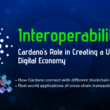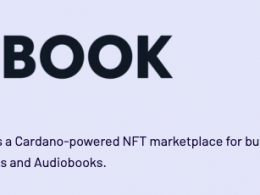
Global finance is accessible to people in developed countries, but inaccessible to people without some creditworthiness or to most people in developing countries.
Blockchain technology is generating a remarkable change in this market, promoting its global adoption, democratizing tools.
That is precisely the mission of the Indigo Protocol, which will allow everyone to have access to financial markets in a synthetic way.
As the great distribution of wealth takes place with money flowing out of the western and developed world to other countries, the Indigo Protocol will be the tool on the decentralized blockchain that will help make this long-awaited distribution more free and fair.
For that the Indigo Protocol will use a tool, synthetic assets.
What are synthetic assets?
Synthetic assets are derivatives of cryptocurrencies that are similar to traditional derivatives, that is, they follow the price of an underlying asset, but are much more composable, accessible and verifiable, as they process transactions on a public blockchain.
Thus, for example, collateral can be locked to create a synthetic asset called iBTC, which has the same value as Bitcoin on the Blockchain, without having real Bitcoin to trade. This gives users exposure to a variety of assets without the need to actually own the underlying asset.
These assets can represent anything that has value in the real world, to be synthesized with transparency, efficiency, low barriers to entry, and decentralization.
Synthetic assets can also be used as a lego piece in a broader DeFi ecosystem, helping to create and sustain massive markets and applications that depend on them. Thus, for example, the team says that it will be possible to create a synthetic dollar asset that can be used in “fiat” loan protocols. The Indigo DAO will ratify the creation of $iUSD via the iAsset Temp Check, so it will be the first Cardano stablecoin solution with the launch of Indigo Protocol. Tweet.
Like most DeFi protocols, Indigo needs cash flows to incentivize the different players on the platform. It can be DEX trading fees, where Indigo users can provide liquidity with their various types of tokens.
Basically, Indigo users can mint new synthetic assets to create new markets on different AMMs (Automated Market Maker), and provide them with liquidity for yield farming.
Users will also be able to use synthetic assets directly in other protocols. For example, iBTC can be used as collateral or as loan money in DApps. Additionally, users will be able to use iETH and other synthetics on specific platforms. Overall, Indigo will bring many new assets in synthetic form to the entire DeFi ecosystem, and more low-barrier-to-entry services to its users.
The Autonomous Oracles that will participate in the protocol will have as their main function to update the real world price of these assets, in the smart contracts that use them. This will establish a market price for the trade, and calculate the collateral ratio of the minted synthetic assets, which will be over-collateralized at all times.
You can see the partners that Indigo presents on its website, such as SundaeSwap, COTI, Ardana, Liqwid, Minswap, Chainlink, Charli3, among others.
Protocol Overview
The following diagrams show different functionalities of the application and how they interact with different users of the Indigo Protocol:
Smart Contracts
The team stated that they chose the Cardano Blockchain for its research-based approach.
The Mint contract that will use the protocol, will provide end users with the ability to mint new synthetic assets, and will manage their corresponding Collateral Deposit Positions (CDPs).
A CDP must maintain a minimum collateral ratio based on the iAsset it mints (normally between 150% and 200%). It will be liquidated if you can’t do it.
Stability Pool
The Stability Pool contract will provide endpoints for providers to deposit iAsset and withdraw rewards from liquidated CDPs.
Oracle
The Oracle contract will provide endpoints for oracles to update the new prices of assets as they change in real-time.
Stake
The Staking contract will provide users endpoints to stake INDY tokens to receive more INDY tokens as a reward. Protocol users also will need to stake to vote on proposals for governance.
Governance
The Governance contract will provide users endpoints to propose changes to the protocol and voting on them.
iAsset Tokenomics
iAsset tokens are over-collateralized synthetic tokens that will be minted and burned via the Mint contract, against a CDP via the Mint smart contract.
iAsset tokens will give users exposure to the price of real assets, as well as allow for fractional ownership of the underlying asset, with a decimal precision of 6.
iAssets will not be able to be created without collateral, which will allow the Indigo Protocol to efficiently price the token.
Tokenomics
INDY is the governance token of the protocol. It will be used primarily for governance, but will also be used as a reward for stakers on the platform.
INDY’s total supply is 35 million tokens accurate to 6 decimal places.
There will be no pre-sale or private distribution to investors prior to launch.
INDY tokens have already been minted, with a monetary policy that does not allow further minting and future burning.
They will be distributed to the community as shown below:
The vesting agreement will distribute the INDY tokens to different agents based on a predetermined schedule.
The INDY token will be staked for use in government processes. INDY token holders who have staked their position will vote in the polls.
Voting power will be weighted according to the total amount of INDYs staked held by each holder. Therefore, users with a higher amount of INDY tokens will have more influence on the voting.
Those who bet on INDY will be rewarded with more INDY. This not only empowers dedicated participants, but incentivizes the people who blockchain it for governance, for the growth of the entire protocol.
Governance
All changes must go through a democratic governance process.
INDY holders will be able to deposit a small sum into the Proposal Deposit to open new proposals for other INDY holders to vote on, such as a new type of synthetic asset to make it minable, remove an asset in the event of unstable market conditions, causing stop being minable, or spend the community fund for new developments, Indigo improvement proposals, and bug bounties, among other things.
After a voting period, if the number of delegated INDY participants and the ratio of affirmative votes to negative votes exceed both minimum requirements, the proposal will be approved.
What is DAO Indigo?
The Indigo DAO owns the Indigo Protocol, including the application, website, and all intellectual property. A DAO (Decentralized Autonomous Organization) is like a company, but instead of being incorporated in a country it is established on a blockchain. At the end I leave an article on this topic.
The Indigo community controls the decisions of the Indigo DAO, through the INDY token. A forum to facilitate community votes.
The Roadmap
Since its inception:
- Q1 2021 —Company launch. Initial design planning.
- Q2 2021 —Development of smart contracts. Demo of web application.
- Q3 2021 —Catalyst Fund 6. Integrating Alonzo node and development.
- Q4 2021 —Audit of Smart Contracts. Integration of PAB.
- Q1 2022 —Development of off-chain solutions.
- Q2 2022 —Testing and auditing. Private testnet.
- Q3 2022 —Partnership development. Vasil upgrades.
- Q4 2022 —Product research and development. Planned mainnet launch.
- Q1 2023 —Launch new iAssets. Development of interoperability solutions.
The Team
Eric Coley, its founder and CEO, tells us on his LinkedIn that he has 15 years of consulting experience in the telecommunications/technology sector.
You can see the rest of the team members here.
. . .
Website: https://indigoprotocol.io
Decentralized Autonomous Organization (DAO): The Brief History, Challenges, and Lessons Learned










